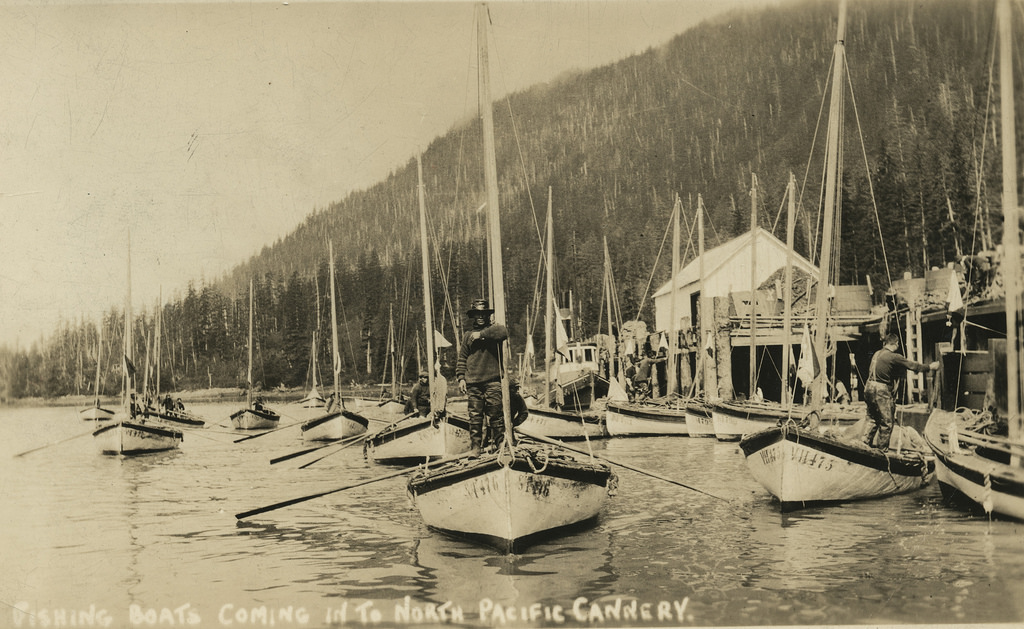While one might assume that cannery work, as labour intensive as it is, may have historically been limited to male workers, women made up large portions of the workforce. As evidenced by personnel ledgers from the Cassiar cannery in 1946 and 1947, women performed many different jobs, including cleaning fish, working on the filling machine, acting as nursemaids, and even repairing nets. In addition to performing paid cannery work, having women and families at the cannery sure contributed to a more stable, domestic environment than would have been found in a strictly male dominated site. While many of the workers listed in these ledgers were cannery workers, it should be noted that there are fishers and boat operators listed as well.
The majority of the women who came to work in the canneries were native women, and most of them were married. While there were exceptions to this rule, it seems probable that it was considered less proper for white, single women to stay in an environment that was traditionally male dominated. In any case, female workers generally accompanied their husbands (or some other male relative), who were often working as fishers, to stay at the canneries over the summer. This meant that there were often children present on site as well. Nursemaids provided care and necessities to those not old enough to work in the cannery or as fishers. The youngest workers recorded in the Cassiar ledgers are 11-year-old males and 13-year-old females. These young workers performed their tasks alongside men and women who averaged in their 20’s and 30’s, but could be up to 80 years old!
In the ledger from 1946, approximately 53.4% of the workers listed were female, while in 1947, women made up about 54.5% of the workforce. Many of the workers listed in the 1947 ledger had been previously listed in the 1946 ledger. This makes it possible to see the evolution of some of the workers, as they progress into different jobs, or as they are joined by family members or their own children. In the 1946 cannery, which is split into three distinct sections, lists all of the packers working that year in the middle section. This list is comprised exclusively of women, though many of the names are listed in the first or final section of the book. This indicates that some women were able to work in different occupations within the cannery in the same year.
Women at the Cassiar cannery were paid a variety of wages depending on their occupation. These wages were generally between 60 and 85 cents an hour, and averaged about 66 cents an hour. It seems that although most women were paid an hourly wage, packers were paid based on how many cans they were able to fill (66 cents per tray). When comparing the male and female workers in the Cassiar ledgers, it seems as though women and men made about the same amount of money for the same type of labour. For instance, those doing net repairs would have made virtually the same wages. That being said, men tended to make more money overall because they were able to perform skilled labour, such as bookkeeping, storekeeping, and much more. In many of these cases, skilled positions were also reserved for white men.
Although the information presented above relates specifically to the Cassiar cannery in the mid-twentieth century, there are assumptions that can be made in regards to other canneries. The first of these is that women and families were, without a doubt, present at other canneries in the region. Second, women worked in a variety of different jobs, which were likely quite similar between canneries. With the knowledge that some of the workers who appear in the 1946 ledger do not appear in the 1947 ledger, there is the question of why they did not return in the following year. Perhaps there was a movement of workers between canneries on a yearly basis, or perhaps families did not need to return each year in order to maintain themselves. This question cannot be answered without further research. In any case, there is a third assumption that can be made in regards to the role of women in canneries throughout the province. This is that women were undoubtedly essential to the workings of the canneries, and the fishery in general. Without native women filling so many important roles, canneries would not have been able to maintain such high outputs of canned salmon each year. The stories of women of these women must be held in great esteem, and they are stories that must continue to be told.
Bibliography
“Cassiar Payroll, 1946,” Ledger, in MS 32 vol. 15, North Pacific Cannery Archives, Port Edward, BC.
“Cassiar Payroll, 1947,” Ledger, in MS 32 vol. 16, North Pacific Cannery Archives, Port Edward, BC.
